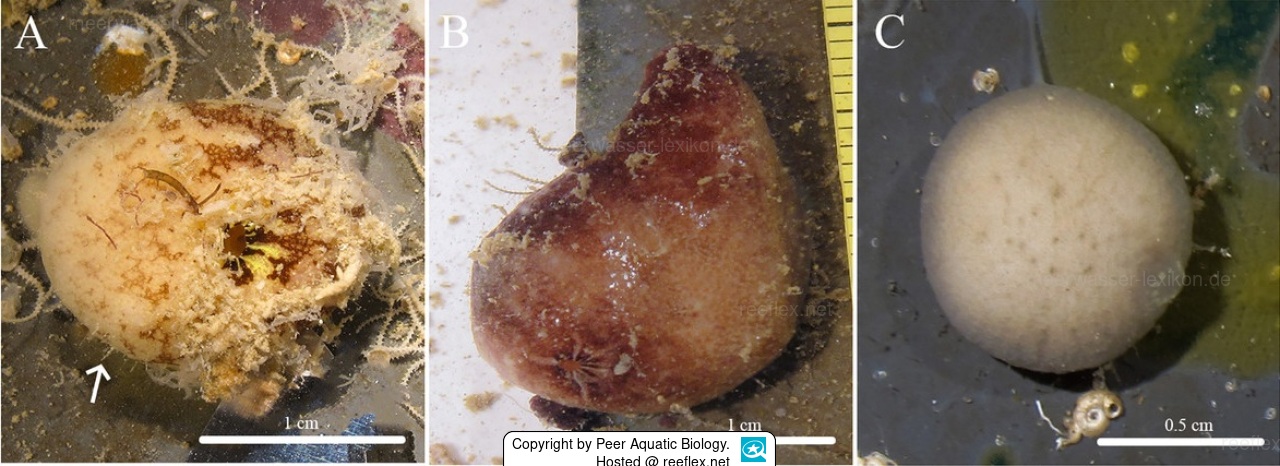Info
Stelletta kela was discovered in 2025 in extremely shallow waters off Moku o Lo‘e, Kāne‘ohe Bay, O‘ahu, Hawai‘i. This sea sponge is characterized by its intraspecific color variations, ranging from white, beige, brown, burgundy red to dark gray.
In addition, the composition of the spicules and the size of the spicules are unique characteristics of this species.
Habitat and ecology:
Specimens were collected from ARMS in mesocosms supplied with unfiltered flow-through seawater at the Hawai'i Institute of Marine Biology (HIMB) in Moku o Lo'e (Coconut Island).
It is noteworthy that no specimens were found in ARMS on a reef surrounded by a climax sponge community during a two-year observation period.
This suggests that these species are pioneers during community development, as they only occurred in habitats completely removed from a fully developed coral reef ecosystem.
This species appears to be strictly sciophilous and has not yet been found on natural calcified coral reef surfaces.
Description:
Stelletta kela is spherical, sub-spherical (1-2 cm in diameter) with irregularly shaped lobes (1.8 × 2.0 cm).
The surface of the sea sponge is smooth and resinous, with occasional megascleres protruding from the sponge surface (Fig. 1A, 1E).
The consistency is tough and difficult to cut.
A single osculum (1 mm in diameter) is present in each individual and is slightly raised by a membrane that can contract upon contact.
The color of the cortex of living specimens varies between white, beige, dark burgundy red, dark gray, and various shades of brown. The color of the choanosome is uniformly cream-colored. In some cases, a mixture of these different colors can be observed in a single specimen. The membrane surrounding the oscula has a distinct, mottled color pattern of yellow, brown, and beige.
Etymology: We use the Hawaiian word “kela,” which means “to protrude” or “to stick out.” This name was chosen to reflect the megasclerae that protrude visibly from the surface.
Distribution: Moku o Lo'e, Kāne'ohe Bay, O'ahu, Hawai'i
Scientific reference:
Nunley RM, Rutkowski EC, Toonen RJ, Vicente J. 2025.
Potential transoceanic dispersal of Geodia cf. papyracea and six new tetractinellid sponge species descriptions within the Hawaiian reef cryptofauna. PeerJ 13:e18903 https://doi.org/10.7717/peerj.18903
Licence
This is an open access article distributed under the terms of the Creative Commons Attribution License, which permits unrestricted use, distribution, reproduction and adaptation in any medium and for any purpose provided that it is properly attributed. For attribution, the original author(s), title, publication source (PeerJ) and either DOI or URL of the article must be cited.
In addition, the composition of the spicules and the size of the spicules are unique characteristics of this species.
Habitat and ecology:
Specimens were collected from ARMS in mesocosms supplied with unfiltered flow-through seawater at the Hawai'i Institute of Marine Biology (HIMB) in Moku o Lo'e (Coconut Island).
It is noteworthy that no specimens were found in ARMS on a reef surrounded by a climax sponge community during a two-year observation period.
This suggests that these species are pioneers during community development, as they only occurred in habitats completely removed from a fully developed coral reef ecosystem.
This species appears to be strictly sciophilous and has not yet been found on natural calcified coral reef surfaces.
Description:
Stelletta kela is spherical, sub-spherical (1-2 cm in diameter) with irregularly shaped lobes (1.8 × 2.0 cm).
The surface of the sea sponge is smooth and resinous, with occasional megascleres protruding from the sponge surface (Fig. 1A, 1E).
The consistency is tough and difficult to cut.
A single osculum (1 mm in diameter) is present in each individual and is slightly raised by a membrane that can contract upon contact.
The color of the cortex of living specimens varies between white, beige, dark burgundy red, dark gray, and various shades of brown. The color of the choanosome is uniformly cream-colored. In some cases, a mixture of these different colors can be observed in a single specimen. The membrane surrounding the oscula has a distinct, mottled color pattern of yellow, brown, and beige.
Etymology: We use the Hawaiian word “kela,” which means “to protrude” or “to stick out.” This name was chosen to reflect the megasclerae that protrude visibly from the surface.
Distribution: Moku o Lo'e, Kāne'ohe Bay, O'ahu, Hawai'i
Scientific reference:
Nunley RM, Rutkowski EC, Toonen RJ, Vicente J. 2025.
Potential transoceanic dispersal of Geodia cf. papyracea and six new tetractinellid sponge species descriptions within the Hawaiian reef cryptofauna. PeerJ 13:e18903 https://doi.org/10.7717/peerj.18903
Licence
This is an open access article distributed under the terms of the Creative Commons Attribution License, which permits unrestricted use, distribution, reproduction and adaptation in any medium and for any purpose provided that it is properly attributed. For attribution, the original author(s), title, publication source (PeerJ) and either DOI or URL of the article must be cited.







 Peer Aquatic Biology
Peer Aquatic Biology




